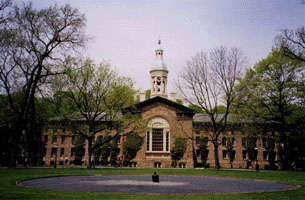Nassau Hall

- Office of the Executive Vice President
- Office of the President
- Office of the Provost
- Office of the Vice President and Secretary
- Office of the Vice President for Campus Life
Today Nassau Hall is used for administrative offices, but this light brown sandstone structure named for England's King William III, of the House of Nassau, was designated a national landmark in 1960 for serving as a model for colonial college structures and as a barracks in the Revolutionary War. In the Battle of Princeton in 1777, British and American troops quartered there at different times and a cannonball that hit the south wall of the west wing left a scar that is visible today. Nassau Hall became the nation's capitol when the Continental Congress met there between June and November of 1783, and the Congress was there when it first learned that the British had signed a peace treaty granting independence to the former colonies. The bronze tigers on either side of the front steps were designed by sculptor A. P. Proctor and presented in 1911 by Woodrow Wilson's classmates, and from those steps some of the campus's oldest buildings are visible - Stanhope Hall, Maclean House, and Henry House. This site, known as the Front Campus, is the setting for Commencement ceremonies, from which new Princeton graduates symbolically leave campus through FitzRandolph Gate. Behind Nassau Hall is Cannon Green, a lawn under which a Revolutionary War cannon is partially buried. The green is bounded by landmark campus buildings including East Pyne Hall, West College, and the twin Whig and Clio halls.
- Office of the President0 feet away
- Office of the Provost0 feet away
- Office of the Vice President and Secretary0 feet away
- Office of the Vice President for Campus Life0 feet away
- Office of the Executive Vice President0 feet away
- E003112 feet away
- Cannon Green187 feet away
- Office of the Dean of the Faculty210 feet away
- Stanhope Hall210 feet away
- E132220 feet away
- E002223 feet away
- Chancellor Green Cafe230 feet away
- Andlinger Center for the Humanities230 feet away
- Chancellor Green230 feet away
- Andlinger Center for the Humanities230 feet away
- Princeton Center for Language Study230 feet away
- Department of Spanish and Portuguese Languages and Cultures230 feet away
- Department of Slavic Languages and Literatures230 feet away
- Department of German230 feet away
- Department of French and Italian230 feet away
- Department of Comparative Literature230 feet away
- Department of Classics230 feet away
- East Pyne Building230 feet away
- E001233 feet away
- E190243 feet away
- E135249 feet away
- E189249 feet away
- Andlinger Center for the Humanities272 feet away
- Program in Journalism272 feet away
- Humanities Council272 feet away
- Society of Fellows in the Liberal Arts272 feet away
- Joseph Henry House272 feet away
- Morrison Hall279 feet away
- Office of the Dean of Undergraduate Students279 feet away
- Office of the Dean of the College279 feet away
- Department of African American Studies279 feet away
- North Guard Gate285 feet away
- E134285 feet away
- Office of Alumni Engagement292 feet away
- Maclean House292 feet away
- Association of Princeton Graduate Alumni (APGA)292 feet away
- Association of Princeton Graduate Alumni292 feet away
- E133331 feet away
- E095341 feet away
- Andlinger Center for the Humanities348 feet away
- Canadian Studies348 feet away
- Program in Hellenic Studies348 feet away
- Program in European Cultural Studies348 feet away
- Program in Humanistic Studies348 feet away
- Program in Judaic Studies348 feet away
- Program in Medieval Studies348 feet away
- Program in the Ancient World348 feet away
- Renaissance Studies at Princeton348 feet away
- Scheide Caldwell House348 feet away
- Taxi Stand358 feet away
- Whig Hall364 feet away
- E096374 feet away
- The Graduate School374 feet away
- Clio Hall374 feet away
- Richardson Auditorium390 feet away
- Alexander Hall390 feet away
- E077400 feet away
- E076420 feet away
- Office of the Dean of Religious Life466 feet away
- Office of Religious Life466 feet away
- Dodge Hall466 feet away
- E072469 feet away
- E051482 feet away
- Murray Theatre486 feet away


